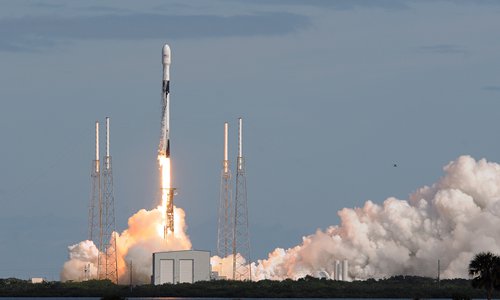HOME >> WORLD
SpaceX satellites may crowd atmosphere
Source:AFP Published: 2020/1/7 18:48:41
SpaceX on Monday launched its third batch of 60 mini-satellites into orbit, part of its plans to build a giant constellation of thousands of spacecraft that will form a global broadband internet system.

The satellite deployment, which was filmed live by a camera onboard the rocket, brings the total number of satellites that are part of the US company's Starlink network to just under 180.
But that figure could one day total 42,000, resulting in far more crowded skies, which has raised concerns among astronomers that they may one day threaten our view of the cosmos.
To put that into context, there are currently around 2,100 active satellites orbiting our planet, according to the Satellite Industry Association.
The launch was broadcast live by SpaceX, a company created by tycoon Elon Musk, who is also chief executive of Tesla.
SpaceX's goal is to control a huge share of the future internet market from space. Several rivals have the same ambition, including London-based startup OneWeb and giant US retailer Amazon, whose Project Kuiper is far less advanced.
Musk hopes eventually to control three to five percent of the global internet market - a share valued at $30 billion a year, or 10 times what SpaceX is earning from its space launches, and plow the profits back into rocket and spaceship development.
SpaceX's boss also entertains a long-time dream of colonizing Mars.

A SpaceX Falcon 9 rocket lifts off from Cape Canaveral Air Force Station carrying 60 Starlink satellites on Monday in Cape Canaveral, Florida. The Starlink constellation will eventually consist of thousands of satellites designed to provide worldwide high-speed internet service. Photo: VCG
The cluster of 60 satellites separated successfully from a Falcon 9 rocket above the ocean between Australia and Antarctica an hour after its launch from Cape Canaveral, Florida at 9:19 pm (0219 GMT Tuesday).The satellite deployment, which was filmed live by a camera onboard the rocket, brings the total number of satellites that are part of the US company's Starlink network to just under 180.
But that figure could one day total 42,000, resulting in far more crowded skies, which has raised concerns among astronomers that they may one day threaten our view of the cosmos.
To put that into context, there are currently around 2,100 active satellites orbiting our planet, according to the Satellite Industry Association.
The launch was broadcast live by SpaceX, a company created by tycoon Elon Musk, who is also chief executive of Tesla.
SpaceX's goal is to control a huge share of the future internet market from space. Several rivals have the same ambition, including London-based startup OneWeb and giant US retailer Amazon, whose Project Kuiper is far less advanced.
Musk hopes eventually to control three to five percent of the global internet market - a share valued at $30 billion a year, or 10 times what SpaceX is earning from its space launches, and plow the profits back into rocket and spaceship development.
SpaceX's boss also entertains a long-time dream of colonizing Mars.
Posted in: AMERICAS